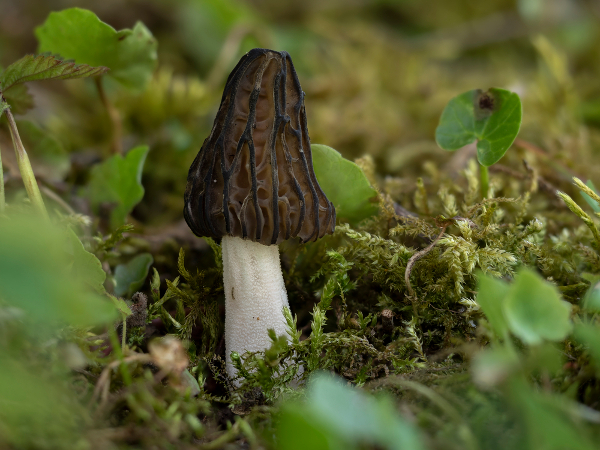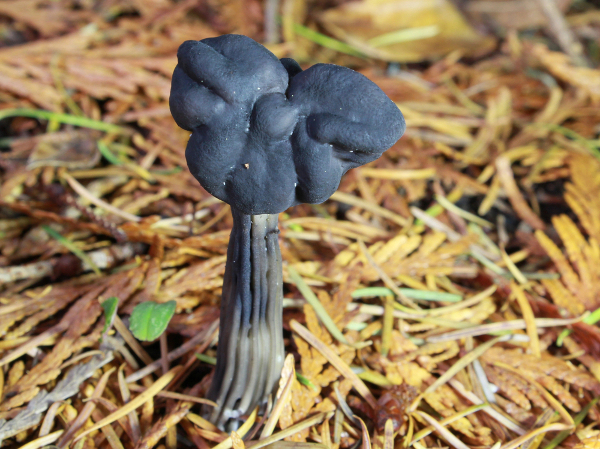Mycology is complex, with mushrooms like the False Morel and Brain Mushroom closely resembling the coveted Morels. Distinguishing between these look-alike fungi is important, as some can be harmful while others are culinary treasures.
Accurate identification is key for foragers exploring the woods for these elusive mushrooms. Let’s explore the subtle yet vital differences that separate these species from Morels, emphasizing the importance of precise identification in the wild.
False Morel Mushroom
The False Morel mushroom is often mistaken for the true Morel, but it belongs to a different genus with distinct differences in appearance and toxicity. While both mushrooms have similar cap and stem structures, the False Morel can be identified by its irregular and lobed cap compared to the true Morel’s honeycomb appearance. False Morels also have a solid stem filled with cotton-like fibers, unlike the hollow stem of true Morels.

One of the key variations between the two mushrooms is their toxicity levels. False Morels contain monomethyl hydrazine, a toxic compound that can lead to serious health problems if consumed. Symptoms of False Morel poisoning include vomiting, dizziness, and in severe cases, liver and kidney damage. It is important for foragers to correctly differentiate between True and False Morels to avoid potential harm.
Important Note
The edible part of the Early False Morel (Verpa bohemica) is the cap. However, it is important to note that Verpa bohemica can be confused with the toxic species Gyromitra esculenta, which is commonly known as the False Morel. It is recommended to be very cautious when foraging for and consuming Verpa bohemica to avoid any potential confusion with toxic species.
To ensure a safe foraging experience, it is important to learn the distinct characteristics of False Morels before consuming any mushrooms.
Giant False Morel (Gyromitra Esculenta)
The giant false morel mushroom, scientific name Gyromitra esculenta, is a species of fungus that resembles the true morel mushroom but is distinct in several important ways. Here are some key differences between the giant false morel and the true morel:
- Appearance: The giant false morel has a brain-like or convoluted cap with irregular lobes, while the true morel has a distinct and morel-shaped cap with a honeycomb-like appearance. The giant false morel can grow quite large, sometimes reaching sizes of up to 30 cm in diameter, hence its name.
- Toxicity: One of the most essential differences between the giant false morel and the true morel is their toxicity. The giant false morel contains a compound called gyromitrin, which can be toxic if consumed. It is recommended to never eat the giant false morel as it can cause severe poisoning and even death. In contrast, true morels are considered safe to eat when properly cooked.
- Habitat: Giant false morels are typically found in forests, especially in areas with coniferous trees such as pine or spruce. They tend to grow on the forest floor among leaf litter and woody debris. True morels, on the other hand, are often found in a variety of habitats including forests, grasslands, and disturbed areas.
- Spore-bearing structure: The spore-bearing structure of the giant false morel is connected to the cap by a distinct stem, while true morels have a hollow, attached stem. This structural difference is one way to distinguish between the two species.

In summary, while the giant false morel may resemble the true morel in appearance, it is important to recognize the key differences between the two, particularly in terms of toxicity. It is essential to be able to differentiate between the giant false morel and the true morel when foraging for mushrooms in the wild to avoid the risk of poisoning.
Brain Mushroom
The Brain Mushroom, with its brain-like appearance, prompts inquiries about its edibility. It is vital for foragers and mushroom enthusiasts to differentiate between edible and poisonous varieties due to its unique texture and appearance.
Knowing the key features of the Brain Mushroom is essential for safe consumption and enjoyment of its distinct visual allure.
Unique Brain-like Appearance
The Brain Mushroom’s unique appearance bears a striking resemblance to a human brain, captivating observers with its intricate folds and creases. Here are four fascinating facts about this peculiar fungus:
- Texture: Its surface is adorned with intricate wrinkles and ridges, mirroring the texture of a real brain.
- Color: Typically seen in pink, tan, or white hues, enhancing its brain-like look.
- Size: Ranging from small as a walnut to as large as a human fist.
- Habitat: Often found on decaying wood or in forested areas, adding to its enigmatic allure.
Edible Vs. Poisonous
When identifying Brain Mushrooms, it is important to differentiate between edible and poisonous varieties. The key distinctions are as follows:
| Characteristic | Edible Brain Mushroom | Poisonous Brain Mushroom |
|---|---|---|
| Cap Color | Light to dark brown | Bright red to orange |
| Texture | Smooth and firm | Slimy and mushy |
| Odor | Earthy, pleasant | Foul, sharp |
| Taste | Mild, nutty | Bitter, metallic |
| Edibility | Safe to eat | Toxic, can cause illness |
Wrinkled Thimblecap
The Wrinkled Thimblecap mushroom resembles a crumpled thimble and is often mistaken for morels. It has a bell-shaped cap with wrinkles or ribs, ranging in color from pale yellow to reddish-brown, measuring 1-3 centimeters in diameter.
Found in deciduous forests on decaying wood or leaf litter, it prefers humid environments and can grow in small clusters. While not toxic, it is not recommended for consumption due to its small size and lack of flavor.
To differentiate it from morels, examine the cap texture, stem characteristics, and overall size carefully.
Half-Free Morel (Morchella semilibera)
The Half-free Morel mushroom, scientifically known as Morchella semilibera, can be distinguished from true morels by its cap partially attached to the stem, giving it a ‘half-free’ appearance. Unlike true morels, the Half-free Morel has a more elongated and less pitted cap.
It is edible but may cause gastrointestinal upset if not cooked thoroughly, so accurate identification is necessary to avoid any risks.

Thimble Morel
The Thimble Morel is a small, conical-shaped mushroom with distinct features that set it apart from other similar mushrooms.
Knowing these unique characteristics and comparing them with other species can help in correctly identifying the Thimble Morel and avoiding confusion during foraging.
Thimble Morel Identification
Identifying the Thimble Morel among other mushrooms can be challenging.
Look for its conical cap, pitted surface, hollow interior when sliced, and its preference for sandy or disturbed soil.
Thimble Morel Look-alikes
Identifying Thimble Morel look-alikes can be tricky for mushroom foragers. One common look-alike is the False Morel (Gyromitra species), which resembles the Thimble Morel in cap appearance but is toxic.
Another look-alike is the Verpa bohemica, or Early Morel, which shares the Thimble Morel’s shape but has an attached cap and a distinct stem.
Elfin Saddle
When foraging for mushrooms resembling morels, keep an eye out for the Elfin Saddle, also known as Helvella. It has a saddle-shaped cap with ribbed texture, ranging from light grey to tan or brown. Found in mixed woods and grassy areas, it grows in spring and fall.
Some Elfin Saddle species are edible after cooking, but others may cause gastrointestinal issues. Consult with a mycologist for accurate identification to avoid toxic look-alikes.

Black Morel
The Black Morel, Morchella angusticeps, is a prized mushroom with a dark, ridged cap and conical to elongated shape. It is commonly found in hardwood forests near dead trees, emerging in spring in humid, temperate areas.
Foragers seek out Black Morels for their exceptional flavor and culinary flexibility. To identify them, look for their dark color, ridged cap, and hollow stem, and always consult experts or guides to avoid toxic look-alikes.



